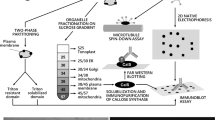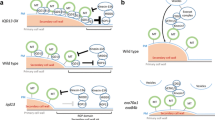Abstract
Indirect immunofluorescence has been used to study the function of cytoplasmic microtubules in controlling the shape of elongated carrot cells in culture. Using a purified wall-degrading preparation, the elongated cells are converted to spherical protoplasts and the transverse hoops of bundled microtubules are disorganised but not depolymerised in the process. Since microtubules remain attached to fragments of protoplast membrane adhering to coverslips and are still seen to be organised laterally in bundles, it would appear that re-orientation of the transverse bundles is due to loss of cell wall and not to the cleavage of microtubule bridges. After 24 h treatment in 10-3 M colchicine, microtubules are depolymerised in elongated cells but, at this time, the cells retain their elongated shape. This suggests that wall which was organised in the presence of transverse microtubule bundles can retain asymmetric shape for short periods in the absence of those tubules. However, after longer periods of time the cells become spherical in colchicine. Neither wall nor tubules therefore exert individual control on continued cellular elongation and so we emphasize the fundamental nature of wall/microtubule interactions in shape control. It is concluded that the observations are best explained by a model in which hooped bundles of microtubules—which are directly or indirectly associated with molecules involved with cellulose biosynthesis at the cell surface—act as an essential template or scaffolding for the orientated deposition of cellulose.
Similar content being viewed by others
References
Anderson, R.L., Ray, P.M.: Labelling of the plasma membrane of pea cells by a surface-localised glucan synthetase. Plant Physiol. 61, 723–730 (1978)
Green, P.B., King, A.: A mechanism for the origin of specifically orientated textures in development with special reference to Nitella wall texture. Aust. J. Biol. Sci. 19, 421–437 (1966)
Gunning, B.E.S., Hardham, A.R., Hughes, J.E.: Evidence for initiation of microtubules in discrete regions of the cell cortex in Azolla root-tip cells, and an hypothesis on the development of cortical arrays of microtubules. Planta 143, 161–179 (1978)
Hardham, A.R., Gunning, B.E.S.: Structure of cortical microtubule arrays in plant cells. J. Cell Biol. 77, 14–34 (1978)
Hardham, A.R., Gunning, B.E.S.: Interpolation of microtubules into cortical arrays during cell elongation and differentiation in roots of Azolla pinnata. J. Cell Sci. 37, 411–442 (1979)
Heath, I.B.: A unified hypothesis for the role of membrane bound enzyme complexes and microtubules in plant cell wall synthesis. J. Theor. Biol. 48, 445–449 (1974)
Hepler, P.K., Newcomb, E.H.: Microtubules and fibrils in the cytoplasm of Coleus cells undergoing secondary wall deposition. J. Cell Biol. 20, 529–533 (1964)
Herzog, W., Weber, K.: Microtubule formation by pure brain tubulin in vitro. The influence of dextran and poly(ethylene glycol). Eur. J. Biochem. 91, 249–254 (1978)
Hogetsu, T., Shibaoka, H.: The change of pattern in microfibril arrangement on the inner surface of the cell wall of Closterium acerosum during cell growth. Planta 140, 7–14 (1978)
Itoh, T.: Microfibrillar orientation of radially enlarged cells of coumarin—and colchicine—treated pine seedlings. Plant Cell Physiol. 17, 385–398 (1976)
Juniper, B.E., Lawton, J.R.: The effect of caffeine, different fixation regimes and low temperature on microtubules in the cells of higher plants. Evidence for diversity in their response to chemical and physical treatments. Planta 145, 411–416 (1979)
Ledbetter, M.C., Porter, K.R.: A ‘microtubule’ in plant cell fine structure. J. Cell Biol. 19, 239–250 (1963)
Lloyd, C.W., Smith, C.G., Woods, A., Rees, D.A. Mechanisms of cellular adhesion II. The interplay between adhesion, the cytoskeleton and morphology in substrate-attached cells. Exp. Cell Res. 110, 427–437 (1977)
Lloyd, C.W., Slabas, A.R., Powell, A.J., MacDonald, G., Badley, A.R.: Cytoplasmic microtubules of higher plant cells visualised with antitubulin antibodies. Nature (London) 279, 239–241 (1979a)
Lloyd, C.W., Slabas, A.R., Powell, A.J., MacDonald, G., Lowe, S.B., Peace, G.: Microtubules in higher plant cells and protoplasts. In: Proceedings of the Fifth International Protoplast Symposium, Szeged, Hungary. Oxford: Pergamon Press 1979b
MacLachlan, G.A.: Cellulose metabolism and cell growth. In: Plant Growth Regulation, 9th International Conference on Plant Growth Substances. pp. 13–20, Pilet, P.E. ed. Berlin, Heidelberg, New York: Springer 1977
Marchant, H.J.: Microtubules associated with the plasma membrane isolated from protoplasts of the green alga Mougeotia. Exp. Cell Res. 115, 25–30 (1978)
Marchant, H.J.: Microtubules, cell wall deposition and the determination of plant cell shape. Nature (London) 278, 167–168 (1979)
Northcote, D.H.: Chemistry of the plant cell wall. Annu. Rev. Plant Physiol. 23, 113–132 (1972)
Palevitz, B.A., Hepler, P.K.: Cellulose microfibril orientation and cell shaping in developing guard cells of Allium: The role of microtubules and ion accumulation. Plant 132, 71–93 (1976)
Pickett-Heaps, J.D.: The effects of colchicine on the ultrastructure of dividing plant cells, xylem wall differentiation and distribution of cytoplasmic microtubules. Dev. Biol. 15, 206–236 (1967)
Rees, D.A., Lloyd, C.W., Thom, D.: Control of grip and stick in cell adhesion through lateral relationships of membrane glycoproteins. Nature (London) 267, 124–128 (1977)
Robards, A.W.: On the ultrastructure of differentiating secondary xylem in willow. Protoplasma 65, 449–464 (1968)
Setterfield, G., Bayley, S.T.: Arrangement of cellulose microfibrils in walls of elongating parenchyma cells. J. Biophys. Biochem. Cytol. 4, 377–381 (1958)
Sloboda, R.D., Rosenbaum, J.L.: Decoration and stabilisation of intact, smooth-walled microtubules with microtubule-associated proteins. Biochemistry 18, 48–55 (1979)
Van der Woude, W.J., Lembi, C.A., Morre, D.J., Kindinger, J.I., Ordin, L.: β-Glucan synthetases of plasma membrane and Golgi apparatus from onion stem. Plant Physiol. 54, 333–340 (1974)
Author information
Authors and Affiliations
Rights and permissions
About this article
Cite this article
Lloyd, C.W., Slabas, A.R., Powell, A.J. et al. Microtubules, protoplasts and plant cell shape. Planta 147, 500–506 (1980). https://doi.org/10.1007/BF00380194
Received:
Accepted:
Issue Date:
DOI: https://doi.org/10.1007/BF00380194




